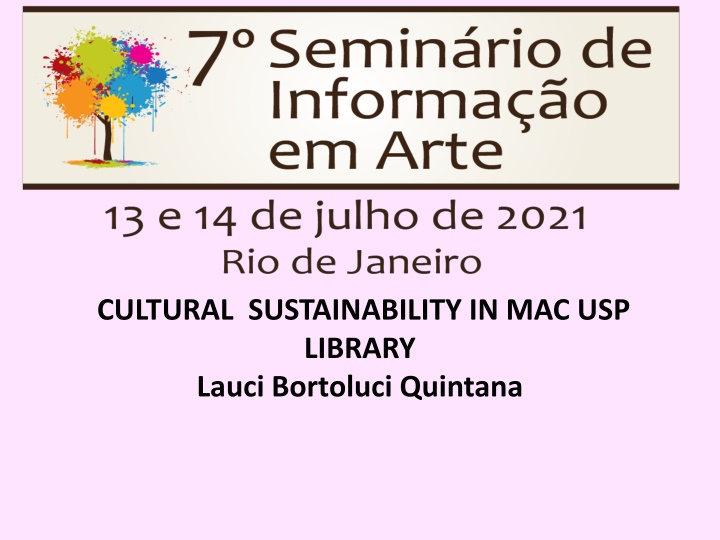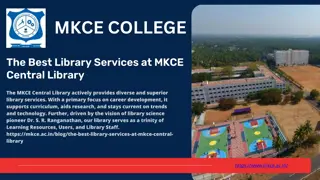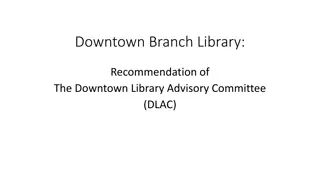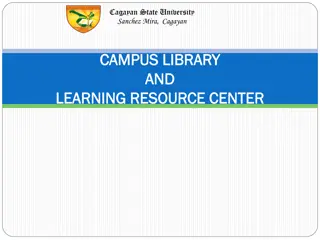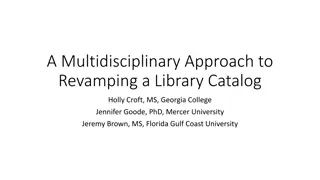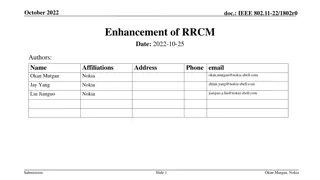Cultural Sustainability in MAC USP Library
The presentation explores the cultural sustainability of bibliographic collections in MAC USP Library through the donations of Paulo Rossi Osir, Mario Zanini, and Walter Zanini. It delves into the connection between these donors, their contributions, and the relationship with the Museum. The concept of sustainable development and cultural sustainability are examined within the context of an art library, emphasizing the cultural dimension of sustainability.
Download Presentation

Please find below an Image/Link to download the presentation.
The content on the website is provided AS IS for your information and personal use only. It may not be sold, licensed, or shared on other websites without obtaining consent from the author.If you encounter any issues during the download, it is possible that the publisher has removed the file from their server.
You are allowed to download the files provided on this website for personal or commercial use, subject to the condition that they are used lawfully. All files are the property of their respective owners.
The content on the website is provided AS IS for your information and personal use only. It may not be sold, licensed, or shared on other websites without obtaining consent from the author.
E N D
Presentation Transcript
CULTURAL SUSTAINABILITY IN MAC USP LIBRARY Lauci Bortoluci Quintana
3 libraries Donated 1963 Paulo Rossi Osir, 1971 Mario Zanini, 2018 Walter Zanini. The aim of this presentation is to connect bibliographic collections sustainability throughout bibliographic research over the three donors, their content, and the relationship between these books and the Museum that housed them. with cultural
Cultural sustainability We intend to bring the Question of the term sustainable development in the 1990s, the tripod development, and the concepts from the 2000s on the fourth pillar, namely, the cultural dimension of sustainability. of sustainable
Methodology Biography of the 3 donors Relations between donations Concepts on sustainable development and cultural sustainability The concept above in an art library
Cultural sustainability Ignacy Sachs: culture is a fundamental part of development, as it implies a project of a country's cultural development based on the society, economy and environment tripod initiates a rethinking about itself, and it should look for projects with a cultural preponderance place in the creative process. identity. Human dimension with a
The 4. pillar Jon Hawkes 2001 Culture is the place where social life takes place. In the local community resides the answer to the debates about the values that sustain the coexistence groups. Culture is development, it operates segments and is the key to think about the future of development. between instance in social for other the all
Cultural sustainability Jon Hawkes 2001 Teixeira Coelho 2007 IMLS Salzburg Seminar 2011 Lyon IFLA 2014 Agenda 2030 UN Goal 11.4 Loach, Rowley & Griffiths 2017 Jon Hawkes 2020
Conclusion The initial proposition is that collections of books donated in the past and that belonged to active artists in the 1930s can be analyzed through the concept of sustainability in its cultural dimension. It is possible to create a cultural process of new interpretations in historical collections and think of them as sustainability factors, which makes the university library trustworthy in its role of providing qualified information with scientific rigor.
Conclusion We affirm, therefore, that a university art library becomes sustainable as it manages to provide access to all its hidden treasures, making collections available, and furthermore, this collections have a logical dialogue between themselves and with the place in which they are inserted, that they have the capacity to exercise a narrative about their formation, their trainers, their function as a binding element of the culture that permeates it. Art collections, whether books, catalogues, magazines, considered when it is possible to contextualize them or when it is possible to relate them to each other, opening and allowing logical research connections. are especially
Conclusion The three bibliographic collections, together with the Museum that housed them, take place as a locus of cultural sustainability, as they contemplate the aspect of heritage preservation, and institutional attitudes that take into account cultural responsibility in promoting a democratic society in the years 2020
